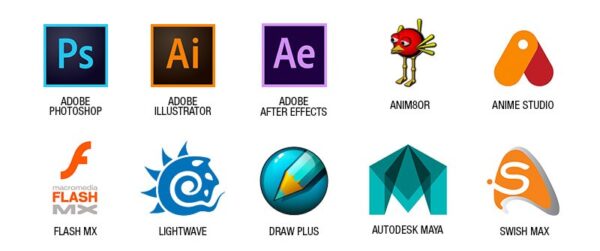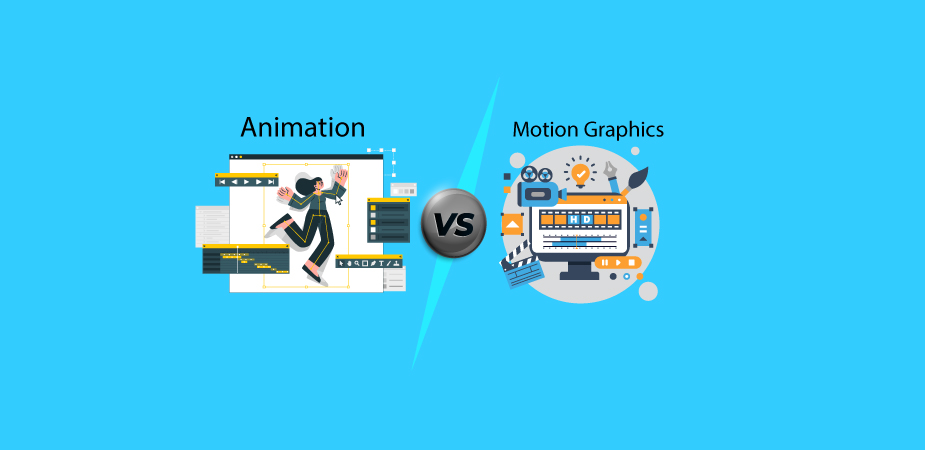Despite the fact that the line between motion graphics and animation is so thin as to be imperceptible to the untrained eye, there is one. In certain cases, it’s impossible to tell exactly which market industry the video explanation belongs to. That’s why a lot of people use them interchangeably: Contrary to popular belief, this is not the case.
A lot of people use the phrases interchangeably, and the distinction isn’t always that clear-cut.
Here, we’ll talk about what motion graphics are and traditional animation, and also what is the main difference between animation and motion graphics. When referring to animation and motion graphics, we’ll also break down when each term is appropriate to use.
But first let’s take a look at some of the different types of animation before we explore the differences between animation and motion graphics.
So, without any further ado, let’s get started.
The Primary Styles of Animation
Animation has been an integral aspect of American culture since the early 1900s. Artists have always sought innovative methods to bring their ideas and tales to life, whether it was through the painstaking process of hand-drawn cell animation or the more recent and popular 3D computer-generated animation.
There are primarily five distinct animation techniques.
Hand-drawn Animation
The term “traditional animation” is used to describe the form of animation used in the earliest major motion movies, which was mostly a frame-by-frame technique done by hand.
2D Animation
2D animation uses images made in 2D applications, is the most prevalent type of animation.
3D Animation
Images produced using a 3D modeling program are called 3D animations. All of the components are freely rotatable within a 360-degree sphere, allowing you to arrange them anywhere you choose for the final composition.
Motion Graphics
When asked to define motion graphics, the term “supplemental animated graphics” comes to mind.
StopMotion
The term “stop motion” refers to the method through which still photographs are transformed into animated 3D works.
An Overview: What is Motion Graphics?
With the use of animation and movement, motion graphics breathe life into otherwise static visual design, often without the need for a linear storyline.
So, do you want the bars on your graph to pop out a little more? That’s a moving picture.
Do you want your website’s logo to rotate continuously? What you just saw is an example of motion graphics.
Animating characters to make a children’s fairy tale come to life is your goal, right? It’s not animation at all. This animation style is unique.
The presence or absence of a narrative drives home the point that the content at hand is either motion graphics or animation. Most examples of motion graphics animation involve the movement of some kind of visual element (an object, a form, or even some text).
Why should you go with motion graphics instead of a much cheaper, static infographic?
Motion graphics can be compared to visual assistance. With the use of motion graphics, even the most complicated concepts can be presented graphically. In other cases, such as when trying to illustrate a more complex or abstract concept, words and static visuals just won’t do.
A small use of animation can explain everything clearly and quickly. Consider how certain password fields make a buzzing noise or turn red if you input the incorrect password, prompting you to try again immediately.
Motion graphics have a large audience because of their appealing visual style. It’s possible that in a professional setting, cartoons might come across as overly juvenile.
However, motion graphics are able to take that lighthearted tone and apply it to serious subject matter. It doesn’t matter what field you’re in because the motion graphics style can help you convey your message with more flair and proficiency.
An Overview: What is Animation?
Motion graphics are a subset of the larger field known as animation. The history of animation goes back more than a century. Want to learn more about the past? Have a look at this fantastic animation resource.
Hand-drawn cartoons, computer-generated imagery, animated television, claymation, and motion graphics are all examples of animation.
None of these groups is exclusive to the others. Although computer-generated imagery (CGI) is the norm for motion graphics, hand-drawn motion graphics are not impossible.
When it comes to promotional videos, the content is what sets motion graphics apart from other animation styles.
Motion graphics are often understood to involve the animation of various graphic design components, such as text, images, and abstract shapes. Motion graphics are a subset of animation that involves the use of movement to enhance static visuals like graphs, infographics, or site designs.
When compared to other creative forms, animation places a greater emphasis on the use of cinematic effects and narrative strategies.
To put it another way, if the graphics in your video move to emphasize a point, you have created what is known as motion graphics. A video is more likely to be classified as animation if it follows a human figure through a series of dramatic events.
So, when do you use the term animation compared to motion graphics?
When you want to narrate a story to your audience, animation is the best technique to use in this. Those familiar with Pixar’s work will agree with the fact that animation can be an effective means of conveying emotional and dramatic content.
While motion graphics excel at humanizing numbers, animation excels at humanizing characters via the use of emotive storytelling, originality, and aesthetic expression.
Animated videos are more costly. Creating motion graphics is typically simpler. Simply said, it’s an animation style that requires less technical considerations.
Nevertheless, more money will be needed for photorealistic computer-generated imagery, hand-drawn or painted artwork, and stop-motion methods.
Main Differences Between Motion Graphics and Animation
Now let’s take a look at the main difference between animation and motion graphics. If you’re trying to decide between motion graphics and animation for video production, the following are some of the significant distinctions that might prove to be game-changers.

Consider scaling up while planning your next video project. The production itself has its own quirks, so let’s see how they stack up against the inside.
Teams
When comparing the average team size in the animation and motion design sectors, there are significant differences.
More than 70% of motion design is done by a team of people less than three. About 75% of animators work in groups larger than 4, and 30% work in groups of 11 or more.
The disparity can be traced back to fundamental differences in resources and the length of time spent on each video. Given the often-rapid pace of video production in the motion design industry, there is simply no time to assemble and train big teams to work on individual projects.
This can be more explanation for why the animation techniques and software used in the motion business are more similar to one another than to the animation industry.
Animators need fundamental skills in directing, editing, and drawing. Knowing the physics of motion is even more crucial than drawing abilities for a motion designer. A vast team of workers used to be needed for animation, but now a single expert can do the job just as well.
Specialization
It stands to reason that the degree of expertise would vary between animation and motion graphics, given the vast differences in team size and production structure between the two fields.
When comparing the jobs involved, it is clear that motion design requires more clean motion design effort. And more general animation and character animation are being produced in the animation business (15% for animation, 11% for motion design).
However, there are subtle distinctions that must be taken into account:
While animators do a wide variety of jobs, 1.16% are in software development (versus 0.36% in motion design).
Similarly, the layout phase plays a far larger role in animation than it does in motion design.
In animation, pre-production is a crucial stage where the basic concept is settled upon, characters are designed, storyboards are created, and the bulk of the revisions are produced.
Overall, in motion design, over 84% of experts have more than 4 distinct responsibilities.
Even with a voiceover, the majority of animators (around 78%) only have to focus on three distinct jobs at once.
Characters
The prevalence of character animation in animation projects vs. motion design projects is a key distinction between the two.
The percentage of motion design assignments that use animation varies substantially amongst different studios (from no characters overall to over 90%).
Creating animation is primarily about developing characters and placing them in settings where they can interact with viewers. Studios often use cartoon characters in 30% of their movies on average. More than 90% of all animated videos have some sort of recurring character.
Tools
It seems to reason that the tools used in animation design would be different from those used in motion design. Adobe After Effects can be used for all motion design projects, whereas Cinema 4D can be used in 54% of situations.
When it comes to animation, After Effects can be used 78% of the time, whereas Flash/animate is only used 57% of the time. More than 30% of studios utilize TVPaint, Harmony, Maya, and 3DS Max, whereas just 17% use Blender.
Depending on the nature of the motion design project, After Effects can also be used to produce more than 90% of the characters used in the project.
After Effects, Animate, Harmony, Maya, and 3DS Max are just a few of the many tools that may be utilized in the animation industry.
In the motion design sector, After Effects and Cinema 4D are the two most popular applications used, but in the gaming industry, there are likely to be more complex chains of using a variety of programs from here and there.

Budget
Since the owners of the product often commission motion design videos, they are meant to promote, and the owners usually compensate the creators.
Consequently, the budget for such videos is typically lesser than that of animated ones, the production time is significantly shorter, and the customer has a greater say in how the final product turns out.
Animation, on the other hand, requires more time and money and is occasionally supported even by non-profits and governments.
The production process can be under the sole direction and supervision of the director and producer.
There are many different types of production, not only the ones listed above. They also clarify the reasons why animation and motion design can seem so diverse.
Relevant Resources:
Motion graphics vs. Animation: When to Use Each Technique
The popularity of online videos is not a secret. Videos, whether animated using motion graphics or another technique, are more effective at generating interest, clicks, and sales than static images alone.
93% of online business owners claim that video advertisements on social media brought them, new consumers. In fact, after seeing a brand’s video on social media, almost half of the viewers took some sort of action.
But you don’t want just any video; you want one that complements your brand and helps you achieve your business objectives. Which begs the question: When should use animation and motion graphics?
Motion graphics are ideal for illustrating a point and highlighting important details. When a plot or narrative structure isn’t necessary, user can use motion graphics techniques instead of animation.
Using motion graphics, you can simplify your complicated offerings and make a lasting impression on your target audience. Keep in mind that motion graphics are, at their essence, visual aids; as such, they are particularly well-suited to conveying otherwise incomprehensible concepts.
When to use other animation techniques
Other forms of animation are preferable if you wish to emphasize sentiment, give a storyline, or establish an emotional connection with your viewers.
Other forms of animation are more suited to generating narratives that help you connect with your audience on a deeper level through the use of storytelling.
Promotion in action
Keep in mind that there is a great deal of crossover between motion graphics and other forms of animation and that distinguishing between them is not always easy.
You can increase your audience engagement no matter what kind of animated video you use.
And we’re here to make sure you do it properly by teaching you everything from the fundamentals of video production and video marketing to the many kinds of videos to the best practices for expanding your video production and making videos for social media.
Excited to Learn More About Animations? – Consult BuzzFlick
We believe it must be a bit of a rollercoaster ride for you to learn about the difference between the two animation styles.
If you are here to explore more about animation for the sake of your video animation project. We can help you. As one of the best animation production companies, we are offering profound video animation and production services.
Our video animation experts have ample knowledge in this matter. If you’re confused about which video style is more suitable for your project, we can help you out.
Plus, we have a professional team of animators who create engaging, beautiful, and eye-catching animated videos.
From 2D animation to 3D animation services, cel animation to motion graphics services, to name a few.
In a Nutshell
Naturally, techniques can vary from studio to studio and project to project. Second, although motion graphics might be considered a subset of animation, they are fundamentally different techniques. Cartoons can use helpful visuals in their productions.
Moreover, the animation is more of a catch-all phrase for the entire field of moving images, whereas motion graphics often refer to specific examples of moving or animated graphic design.
Finally, in comparison to a static image, the animation is far more interesting since it is alive and can move. It’s enlightening and enjoyable all at once.
While motion graphics can be used to accomplish the same aims in a wide variety of contexts, stylization allows for greater scope in terms of creativity, interpretation, etc.
Contact a business specializing in motion design for a more in-depth explanation and advice on deciding between motion graphics and animation for your project.




